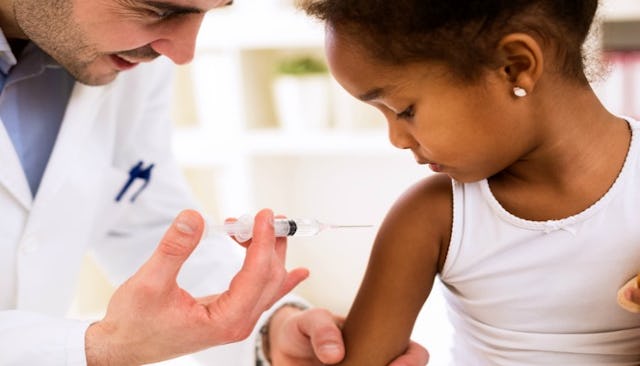Measles Cases Are Cropping Up Again. Just Vaccinate Your Damn Kids, Please.

Vaccinate your kids.
No, seriously, vaccinate your kids. Don’t throw your woo at me. I’m heartily sick of people reading a little bit of science, misinterpreting it, and putting us all at risk for diseases we should have wiped out ages ago. Like measles, which the U.S. had 70 cases of last year, 188 cases the year before that, and a whopping 667 cases in 2014. And yes, the majority of people who contracted the disease were unvaccinated.
The MMR vaccine protects your child against not only measles but also mumps and rubella. Mumps, an often painful virus that affects the salivary glands, can be spread year-round. In January, a mumps outbreak hit Colorado, with 24 of the 26 reported cases in the Denver metro area alone, and infections are expected rise. Washington State is also reporting a rise in mumps.
The CDC counted approximately 20,000 pertussis (whooping cough) cases in 2015 — and pertussis often goes unreported, so those numbers are likely far, far higher. Children can’t be vaccinated for pertussis until 3 months of age. Before that time, they are perilously vulnerable, which is why 1,970 of those 20,000 cases reported in 2015 were children under 6 months old. In total, six people died, three of them children under the age of 1. All because everyone won’t get jabbed. And by “everyone,” I mean your kids — specifically.
Don’t tell me that the aluminum in the vaccines will give them Alzheimer’s. According to the Children’s Hospital of Philadelphia (CHOP), the amount of aluminum in a vaccine is “similar to that found in a liter of infant formula.” Smug about your breastfeeding? Don’t be. Breastfed infants still ingest 7 milligrams of aluminum in their first six months of life, compared to the 4.4 mg they get from vaccines. You don’t fret that your milk is going to give your kids an incurable brain disease.
Then there’s the formaldehyde. Horrors! Except the amount of formaldehyde in a vaccine is less than the amount circulating in your infant’s body. Five times less, at least. Moreover, CHOP explains that formaldehyde necessary for human metabolism. The dosage amount is what makes formaldehyde poisonous, and this dose is too low to do anything to precious Moonbeam and Starshyne.
Don’t say that we give too many vaccines at once, and you suspect that may cause, well, if not autism, then maybe some developmental delays and ADHD. Don’t say that we give too many vaccines now. Thirty years ago, we vaccinated against eight diseases, according to CHOP’s Vaccine Education Center. There were a little more than 3,000 bacterial and viral proteins in those vaccines. Now we vax against 14 diseases, and those use only 150 immunological components. So your child gets fewer antigens introduced to their system than you did as a child, not more.
Don’t tell me that your decision not to vax has no effect on other people, either. First of all, there’s a thing called herd immunity. Basically, if a certain number of people are are immune to a disease, the disease will go away. That’s how we killed polio. That’s why we don’t have diphtheria outbreaks every winter. Herd immunity protects those who can’t get vaccinated, including, in many cases, the pregnant and the newborn, the immunocompromised and the allergic. So when you refuse to vaccinate little Timmy, you compromise community immunity and make it more likely that others will get sick. That includes little babies and elderly people — people who could die from the same sickness that just inconveniences you, babies like 1-month-old Riley Hughes in the video below, who passed away after he contracted whooping cough.
(Trigger Warning: Critically Ill Infant)
And don’t hide behind the banner of free choice. You make a medical decision for your child, a decision you think is best for them. That’s your right as a parent. But that decision has consequences — real consequences — for the health of the community around them. I understand that you’re scared of side effects. But the good you do by vaccinating far outweighs the chance of side effects. It’s your civic responsibility to help your community, and that means getting shot up with antigens that will save you from sickness. My kids don’t like getting shots. They cry. I tell my oldest that he’s being a hero; he’s helping to keep not only himself healthy, but also other people. If he had a choice, he wouldn’t get jabbed. But he doesn’t understand that his free choice pales in comparison to the public health benefits of mass vaccination.
Don’t tell me vaccines didn’t kill polio in the United States. Don’t tell me it didn’t eradicate smallpox or diphtheria. Don’t use the old “better sanitation and medication” argument. Those things will help mitigate the mortality rate of a disease, but they won’t magically make it disappear. Only a population substantially immune to the disease — the threshold for community immunity varies — will make a disease go away.
So just vaccinate. Just do it. Yes, your child will cry and be uncomfortable. Yes, you’ll worry about side effects, but it’s almost 100% likely your kid will experience nothing but a fever. My kid was the 1 in 1,000 who broke out in a measles-like rash in response to an MMR vax. He still got the rest of his shots. That’s because immunization isn’t just best for your child. Immunization is best for your community. And you don’t live in a bubble. You have a solemn responsibility to the very young and very old, to the cancer patient, to the immunocompromised. Don’t mess it up. Vaccinate.
This article was originally published on